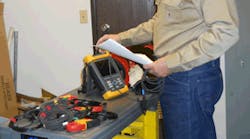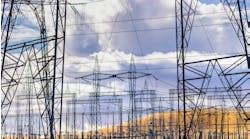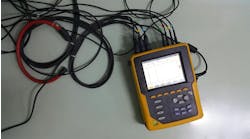Analyzing electrical parameters associated with distributing electricity is viewed by many as complex engineering work. Yet, for engineers, electricians, and technicians troubleshooting equipment problems these days — and for contractors maintaining electrical systems they may have once installed — measuring power quality is becoming as much of a necessity as using the clamp ammeter to find out why the overloaded circuits keep tripping.
When any electrical system fails to meet its purpose, it is time to investigate the problem, find the cause, and initiate corrective action. The purpose of the electrical distribution system is to support proper operation of the loads. When a load does not operate properly, the quality of the electric power in the system should be suspected as one possible cause. Whether it’s used for troubleshooting purposes or to obtain baseline data, measuring/analyzing electrical system parameters is called power quality analysis.
The setup and use of power quality equipment — and obtaining and interpreting usable data — can be intimidating for those not familiar with the process. The key to success is knowing where and how to measure as well as how to interpret the results.
Measurement Tools
Several measurement tools are available for power quality measurement. Power quality analyzers are the most commonly used tools to observe real-time readings and also collect data for downloading to computers for analysis. While some are permanently installed in the distribution system, handheld analyzers are necessary for many applications, especially troubleshooting.
Handheld power quality analyzers are fairly lightweight (generally 4 lb to 5 lb) and will measure a variety of parameters. The most typical include voltage, amperage, frequency, dips (sags) and swells in voltage values, power factor, harmonic currents, and the resulting distortion and crest factor, power and energy, voltage and current unbalance, inrush current values, and light flicker. If an analyzer measures and records such basic parameters, you can address most power quality issues successfully.
Portable data loggers typically monitor many of the same parameters as the power quality analyzer; however, they are meant for long-term recording (days to several weeks). In addition, the data logger does not typically provide the real-time values on-screen that an analyzer can provide. Additional test equipment, such as scopemeters and recording digital multimeters, also find specific use applications.
The Process
Conducting a power quality survey begins with planning. Simply determine the purpose of the survey, and write it down in a notebook or binder that will be used throughout the process to organize and maintain data. Start with a good one-line diagram of the facility electrical distribution system. If one does not exist, then this is an excellent time to get one up to date.
If conducting a general power quality survey to obtain baseline data for future comparisons — or to help identify any immediate hidden electrical distribution problems that may exist — start monitoring as close as practical at the point of service. Beware, however, measuring near the service typically means large amounts of fault current available. Therefore, be careful when connecting the analyzer at a point in the distribution system downstream of the main breaker that limits incident energy levels to acceptable values. Because power quality problems can either come from the electric utility — or be generated within the facility — be sure to contact the utility in order to identify any possible issues on this side of the meter.
Inside the facility, continue to “drill down” into the distribution system following the one-line diagram. Obtain data at the source of each separately derived system. For example, take recordings at the first panelboard or switchboard after a 480V to 208Y/120V transformer. Be sure to mark up drawings, and take plenty of notes for future reference.
Digital cameras work well for quickly capturing nameplate data and later identifying exact connection locations. Note plant conditions and any equipment that was running. Print out digital pictures, and maintain all data for the survey in the notebook binder. These notes will become valuable when analyzing data and conducting further studies.
Follow manufacturer’s instructions for connecting and setting up the analyzer. Because of the amount of test equipment and supporting documentation that is needed, it is often best to have an equipment cart dedicated for power quality work. In addition to technical expertise, the underlying key to a successful survey is planning and organization. Three common mistakes when connecting power quality analyzers are:
- Failure to observe current polarity. Make sure the arrow on current clamps points toward the load. If the arrow points in the wrong direction, a negative current value is obtained on the analyzer for that phase.
- Not matching current/voltage probes. If analyzer input phase “A” is clipped onto phase “B,” it is obvious readings will be erroneous. Color code individual leads such that voltage and current leads for each phase are the same color, and connect carefully to prevent such errors.
- Relying on battery power to complete a lengthy monitoring session. While fully charged analyzer batteries are meant to last hours, nothing is more frustrating than to find key power quality events were not recorded because the analyzer shut down. Be sure to keep the analyzer plugged into an AC source for recording parameters when you will be away from the equipment.
Analyzing the Data
Whether observing values real-time on the analyzer color screen or analyzing downloaded data on the laptop back in the shop, an understanding of power quality parameters and their characteristics must be understood. IEEE Power Quality Standards and NFPA 70B are excellent resources to help understand power quality terminology, issues, and corrective actions. To help with data analysis, each manufacturer provides software for its specific test equipment. Here is what to look for when analyzing data:
If experiencing overheating of neutrals, overheating of transformers or motors, nuisance tripping of circuit breakers, blown fuses, unusual audible noise in larger distribution equipment, or if distorted voltage sine waves are found, then suspect harmonics. The magnitude of the various harmonic frequencies and the amount of total harmonic distortion created by the harmonics are the critical factors to determine the severity and correction techniques for any harmonic problem. Measure harmonics at their source, (e.g., VFD, UPS), and expect them to lessen further upstream from the equipment. Sine wave distortion is a good indicator that you should analyze harmonics values (Figures 1, 2, and 3).
Transients are extremely short-duration voltage surges, sometimes incorrectly called “spikes.” The voltage levels achieved during a transient can cause equipment problems ranging from malfunction to destruction. If you’re experiencing unusual insulation failures, record data for extended periods at the equipment. The most severe transients are often caused by nearby lightning strikes. However, they can also be the result of switching of loads.
Voltage sags and swells are the most common type of power quality culprits. While definitions provide specific numbers for magnitude and duration of changes up or down in voltage values, the bottom line is changes of 10% or more in either direction from normal voltage can cause problems. These conditions only need to last from ½ cycle to 1 min. Too high a voltage (swell) can occur when large loads are dropped off the line. Sags, the decrease in voltage, are typically more bothersome and can cause contactors and relays to chatter or drop out completely. Equipment such as PLCs and variable-speed drives can malfunction, and computers may lock up. Observe voltage recordings for sags and swells, and try to relate these variations to changes in plant conditions or operations, (e.g., a chiller or other large load cycling off or on).
Voltage unbalance between phases on a 3-phase motor can cause current values to reach six to 10 times the value of the voltage unbalance. Because current causes heat — and overheating is one of the leading causes of motor failure — distribution systems should be monitored for unbalance. Unbalance is often the result of single-phase loads cycling off and on, so monitor for unbalance at panelboards and switchboards throughout a typical plant cycle.
The key to success in power quality measurement and analysis can be attributed to success in three key areas. Set goals and plan the survey by reviewing one-line diagrams to determine points to monitor. Learn the functions and features of the test equipment and how to use it to capture the needed values. Finally, know what to look for while observing data whether in the field or after it is downloaded to the computer. Learning how to successfully measure electrical parameters associated with proper operation of equipment is obviously a key step in solving power quality issues.
Burnett is a certified energy auditor and trainer for NTT, Centennial, Colo. He can be reached at [email protected].




